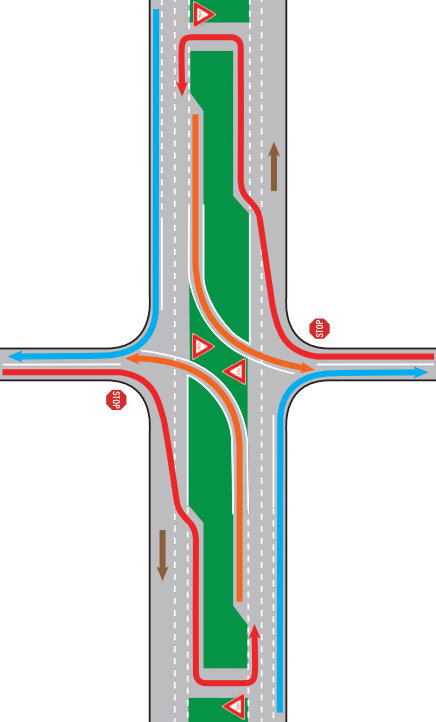
Although drivers will have to travel slightly further to get where they want to go, using RCIs can take the same or less time than trying to wait for a safe and appropriate gap to cross traffic. RCIs also are designed to fully accommodate the wide turning radius of tractor-trailer trucks and other large vehicles, such as school buses.
The point of a RCI is to greatly reduce ‒ or even eliminate ‒ a significant number of severe crashes common when drivers must cross-over busy highways to reach another road.
In the RCI design, drivers turn right in the same direction of traffic, and merge safely into the left lane to prepare to make a left turn in the direction they intend to travel. This option uses an extended deceleration lane, basically adding a third lane on the highway to enable traffic making a left turn onto opposing lanes to safely pull off the main line, out of the way of high-speed traffic. Also, acceleration lanes may be constructed to allow traffic an opportunity to gain speed after turning onto the highway.
A RCI is one of many countermeasures available to improve intersection safety performance. Presence of specific traffic and site conditions favor their installation; they are not an appropriate treatment in all cases, and most often not the first intervention that will be installed. However, when conditions are right, they've demonstrated extraordinary effectiveness at keeping people safe.
In June 2015, INDOT opened its first RCI at U.S. 41 and State Road 114 in Newton County. By mid-2019, six more had been built. Others are planned where crash history, traffic volumes, and other road conditions justify the design.
Improved Intersection Safety
RCIs have proven to be a safer alternative to a traditional roadway intersection on a four-lane highway because they eliminate or substantially reduce right-angle crashes, the crash the most responsible for fatalities and serious injuries at intersections. In fact, the installation of RCIs at similar intersections throughout Indiana and the nation have shown a substantial decrease in fatal and serious injury crashes.
RCIs eliminate the need for motorists to cross the high-speed lanes of traffic to get to the opposing lanes. Studies done by the National Cooperative Highway Research Program show RCIs provide a significant reduction in right-angle, “far” side crashes.
In a traditional intersection there are 42 different conflict points where an accident can occur. Of those, 24 conflict points can cause serious crashes such as T-bone or right angle crashes. A RCI can have no more than 29 possible conflict points and some RCIs can be designed so that there are zero crossing conflict points.
Driving a RCI
The RCI eliminates the cross-over between the four-lane divided highway. In the RCI design, drivers turn right in the same direction of traffic and merge safely into the left lane to prepare to make a left turn in the direction they intended to travel. This option uses an extended deceleration lane, basically adding a third lane on the highway to allow motorists making a left turn onto opposing lanes to safely pull off the main line, out of the way of high-speed traffic.
Recent Statistics
Nationwide, statistics show a more than 50% decline in crashes where RCIs are installed. Fatal crashes decline by as much as 85%.
Since 2015, INDOT began installing RCIs at four-lane highway intersections in Indiana. These intersections have shown a substantial decrease in fatal and injury crashes since RCI installation.
INDOT has conducted performance analyses of crashes at each RCI, comparing pre-construction crash frequency and severity with post-construction data over similar time periods, ranging from 1½ to 5 years.
In overall effectiveness, INDOT’s analysis showed that the seven RCIs:
- Reduced fatal and injury crashes by an average of 81%.
- Reduced property-damage crashes by an average of 58%.
- Reduced crashes of any severity by an average of 68%.
INDOT’s analysis showed a dramatic reduction in fatal and injury vehicle crashes at each RCI:
- Fatal and injury crashes at each intersection declined between 64% and 100%.
- Property-damage crashes at each intersection ranged from No Change to 100% reduction.
- All crashes of any severity at each intersection declined between 38% and 100%.
INDOT continues to track the safety performance of these and future RCIs to assess their effectiveness and advance our understanding of the traffic levels, design, and site conditions most suitable for this highway feature.
Related Links
Contact Information
Transportation Services Call Center
Indiana Department of Transportation
100 N. Senate Ave., IGCN 755
Indianapolis, IN 46204
855-463-6848
indot4u.com
